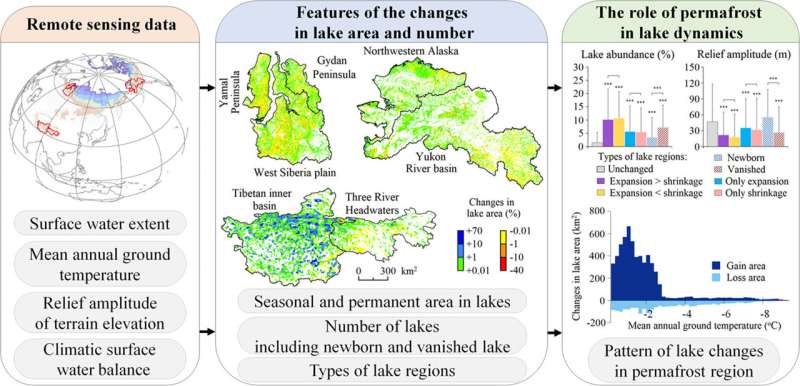Study reveals changes of lake area in permafrost regions of arctic and Tibetan Plateau from 1987 to 2017

As an important indicator of climate change in cold regions, changes in lake area are important for understanding hydrological and ecological processes in cold regions.
The interplay between lakes and permafrost is complex. Previous studies have shown significant zonal differences in the variation of lake area in permafrost regions. However, the seasonal variation of lakes in permafrost regions and the conditions under which they occur are unclear.
Based on high-quality remotely sensed global water body products, a research team led by Prof. Ran Youhua from the Northwest Institute of Eco-Environment and Resources of the Chinese Academy of Sciences investigated lake area changes from 1987 to 2017 in seven carefully selected watershed permafrost areas of the Arctic and Tibetan Plateau with a 30-m resolution, to explore different effects of surface water balance on lake area change under different permafrost, terrain and climate conditions.
This study was published in Science of The Total Environment.
The study showed that the maximum (seasonal and permanent) surface area of lakes in the permafrost regions of the seven basins net increased by 13.45% from 1987 to 2017. Among them, the seasonal lake area net increased by 28.66%, while the permanent lake area net increased by 6.39%. A total of 2.99% of the maximum surface area of lakes disappeared, including 2.48% of the seasonal surface area and 3.22% of the permanent surface area.
Additionally, inter-basin comparison showed that the annual lake surface area decreased in the Arctic basin, but increased in the Tibetan Plateau.
On the lake region scale, the contained lakes were classified according to the characteristics of annual area change, including no change, homogeneous changes (only expansion or only shrinkage), heterogeneous changes (expanded lakes neighboring shrunken lakes, EL-SL) and abrupt changes (newborn or vanished lake). It was found that lakes with heterogeneous changes accounted for more than a quarter of all lakes.
By comparing the environmental conditions between different classifications, the researchers found that lakes with variable lake area, especially heterogeneous changes and abrupt changes, are distributed in the regions with low and flat terrain, high-density water bodies and high permafrost surface temperature.
“The change of surface water balance cannot completely explain the change of lake area in the permafrost area,” said Prof. Ran. “We further revealed the potential critical point effect of permafrost degradation on lake change from the perspective of data.”
More information:
Yang Su et al, Remotely sensed lake area changes in permafrost regions of the Arctic and the Tibetan Plateau between 1987 and 2017, Science of The Total Environment (2023). DOI: 10.1016/j.scitotenv.2023.163355
Citation:
Study reveals changes of lake area in permafrost regions of arctic and Tibetan Plateau from 1987 to 2017 (2023, May 26)
retrieved 26 May 2023
from https://phys.org/news/2023-05-reveals-lake-area-permafrost-regions.html
This document is subject to copyright. Apart from any fair dealing for the purpose of private study or research, no
part may be reproduced without the written permission. The content is provided for information purposes only.
For all the latest Science News Click Here
For the latest news and updates, follow us on Google News.

